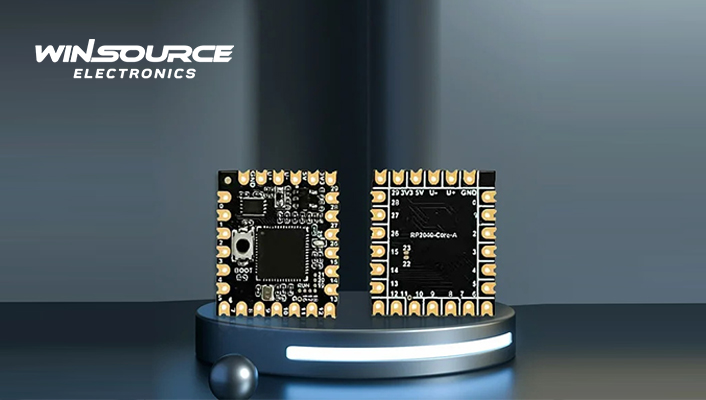
With the rapid growth of embedded systems and IoT applications, the RP2040 microcontroller has become a key component in the field of electronic design due to its high performance, low power consumption, and diverse peripheral interfaces. Built on the ARM Cortex-M0+ dual-core processor architecture, the RP2040 features up to 30 programmable I/O pins, including PWM, SPI, I2C, UART, and other interfaces, making it a go-to choice for developers and designers. This article will analyze the electrical characteristics of the RP2040 in practical applications from a circuit design perspective, with a particular focus on its I/O characteristics, power management, and connectivity features to help designers optimize their use of this microcontroller.
1. Basic Electrical Characteristics of RP2040
The basic electrical characteristics of RP2040 include its operating voltage, power consumption, clock frequency, and I/O pin properties. Understanding these features is crucial for ensuring stable and efficient system performance.
Operating Voltage
RP2040 operates within a voltage range of 1.8V to 3.3V. Designers must ensure that the power supply stays within this range for stable operation. Due to its low-voltage design, RP2040 is widely used in low-power, long-duration embedded applications, especially for battery-powered projects.
- Low Power Feature: The RP2040 operates efficiently at low voltages, making it ideal for applications that require low power consumption, such as portable or long-term devices.
- Power Supply Design:To ensure stable power supply, designers may consider using Low Dropout Regulators (LDOs) or DC-DC converters that can maintain the voltage within the operating range.
Power Management
The RP2040 uses the ARM Cortex-M0+ processor, which contributes to its low power consumption. In addition to the base clock frequency of 133 MHz, the RP2040 supports multiple power modes, such as sleep mode and deep sleep mode. Designers can optimize power consumption by controlling the chip’s operational state.
- Dynamic Voltage and Frequency Scaling (DVFS): The RP2040 adjusts its clock frequency according to the processing load, which helps reduce power consumption. Designers can select lower frequencies during periods of light load or idle states to conserve power.
- Sleep Mode: In sleep mode, most of the RP2040’s functions are turned off, with only essential clocks and external interrupts remaining active. This mode is ideal for scenarios where the device does not need to perform intensive processing tasks.
- Deep Sleep Mode: When no external interaction is needed, RP2040 can enter a deep sleep mode that further reduces power consumption, making it suitable for long-term battery-powered applications.
Clock System
The RP2040 features an internal clock generation system capable of reaching a maximum frequency of 133 MHz. The clock system is highly accurate, enabling the chip to balance performance and power consumption.
Developers can choose from different clock sources and configure the clock frequency based on specific application needs. This flexibility allows for tuning the processor’s performance relative to the power requirements.
RP2040’s I/O Characteristics
RP2040 features 26 GPIO pins, which can be configured for various input/output functionalities, including digital I/O, analog input, PWM output, serial communication, and more. Understanding the properties of these I/O pins is essential for proper circuit design.
Digital Input/Output (GPIO)
The GPIO pins of the RP2040 support 3.3V logic levels, meaning they can interface directly with other components that use 3.3V systems. Furthermore, these pins can be configured for input, output, or interrupt modes, enabling the handling of digital signals.
The GPIO pins can interface with sensors, actuators, or other digital devices. They can be programmed for input or output. As input, they receive signals from external components. As output, they send control signals to drive devices. GPIO pins can also trigger interrupts. This enables the RP2040 to react to changes in external conditions. Interrupts are useful for applications requiring quick response times, such as a button press or sensor activation.
Analog Input (ADC)
RP2040 provides three 12-bit ADCs, which are capable of sampling analog signals at a maximum input voltage of 3.3V. These ADCs are useful for applications requiring analog-to-digital conversion, such as reading values from sensors measuring temperature, humidity, or light levels.
- Analog Signal Conversion:The ADCs allow designers to easily integrate analog sensors into their designs. These 12-bit ADCs provide a high level of precision in converting analog signals into digital data.
- Voltage Range:The input voltage range for the ADC is 0V to 3.3V, which matches the operating voltage of the RP2040, ensuring compatibility with other system components.
PWM Output
The RP2040 supports PWM output on several GPIO pins. This feature is essential for applications such as motor control, LED dimming, and signal modulation.
PWM allows designers to control motor speed, LED brightness, and the modulation of other analog outputs. The frequency and duty cycle of PWM signals can be programmed to meet specific application needs.
The RP2040 microcontroller offers a robust set of electrical features, making it ideal for various embedded system applications. Its low operating voltage and power consumption are perfect for battery-powered, energy-efficient designs. The flexible clock system and dynamic power management enable developers to optimize both performance and power efficiency. Additionally, the versatile GPIO pins support digital and analog I/O, PWM, and serial communication, giving designers the flexibility to create diverse embedded systems.
For seamless integration into applications, a reliable supply chain is crucial. WIN SOURCE, a global distributor of electronic components, offers local support and 24/7 logistics solutions. This ensures timely access to the RP2040 and other components. Their efficient global warehouse network and real-time shipment tracking help prevent supply delays, streamlining the design and manufacturing processes. With WIN SOURCE providing a stable supply chain, developers can focus on creating innovative, high-performance embedded systems.

COMMENTS